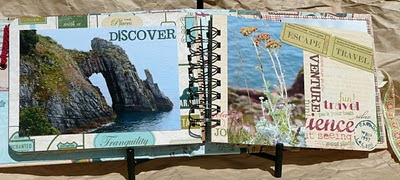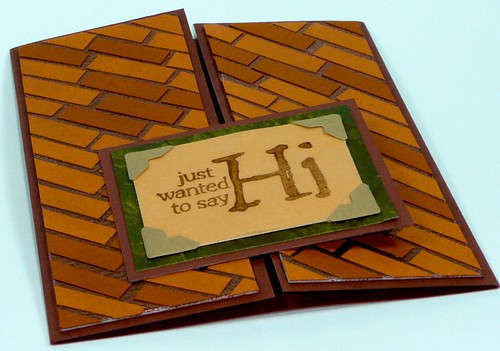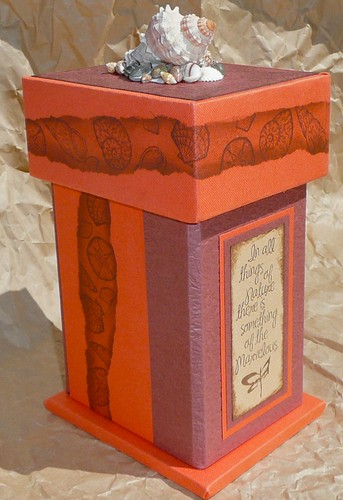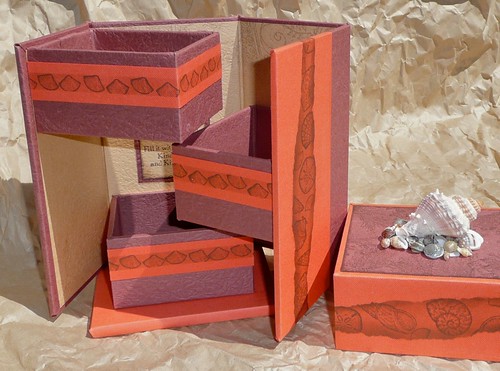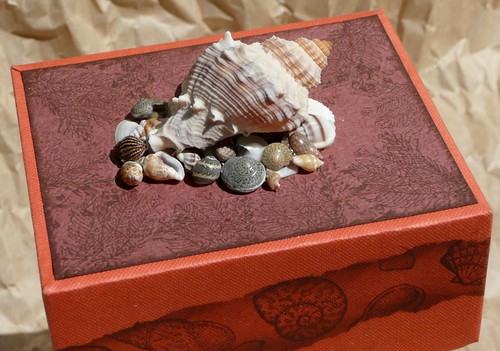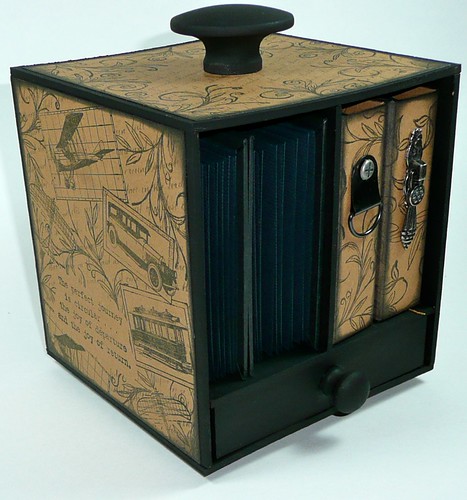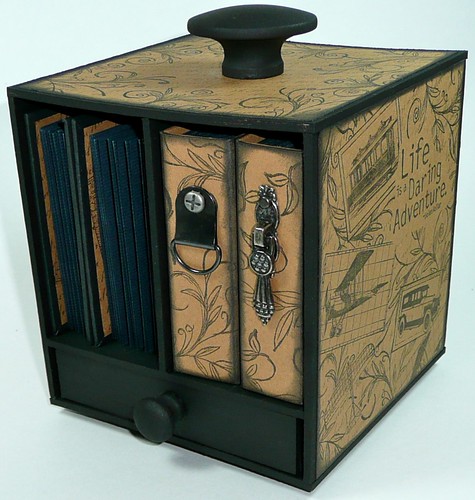I was recently honored to be asked to design a piece for Making Memories using their new Panorama collection of papers and embellishments. I was featured on their blog last week. In case you missed it, here is my take on the project.
First, I created a cover for my project. I used several pieces of book board, covered with paper. I just loved the postage stamp border, so I wanted to make this the most prominent part of the cover. I glued ribbon on the inside to create a nice tie for the cover. You probably can't tell from the picture, but the airplanes are embossed - very cool effect.
When you open the cover, a coil bound album is on the right, and tags are on the left. Pockets hold both in place. I've previously done a tutorial on how to make a coil bound album and pocket. The pocket on the right is 3/8" wider than the width of the book. Making the cover is similar to my post bound album tutorial, but with three pieces instead of two.
The tags were from scraps of the paper and some of the trading cards. I used the index prints from my order, rub-ons, and ribbon to embellish the tags.
I decided to spend most of my embellishing energy on the cover of the book. To start, I did an image transfer of one of the patterned papers onto chipboard. I primed the surface with gesso, and while it was still wet, placed the patterned paper on top. When dry, I wet the paper and rubbed off the paper back. I used stamps from the collection and two (Remember and Journey) from my Club Scrap stash to recreate a little word collage. When stamping on the image transferred paper, the ink does naturally bleed a little bit. Finally, I used more pieces from the kit and index prints to embellish the cover.
The inside pages of the book are chipboard covered with the patterned paper. I used a lot of the rub ons inside the book. I love using these on top of photos. The pictures from Devon and Cornwall last summer were so gorgeous on their own, I didn't feel they needed a lot of extra embellishing.
I really love the collage words on the right hand side. This is where I got my inspiration for the cover.
I love how this worked out on the right. The "sign" says "Smell the Roses" with "STOP" in the center. This is another paper with embossing on it, which doesn't really show in the photograph.
I also found that the Distress Inks by Tim Holtz coordinate really well with these papers. In particular, I used Weathered Wood, Vintage Photo, Peeled Paint, and Fired Brick.
Having trouble finding some of these items? I recommend Blockhead Rubber Stamps for the distress inks, and Two Peas in A Bucket for the Making Memories items.
Sunday, July 25, 2010
Friday, July 23, 2010
Carpet Tape Techniques - more scrappy cards
After my first set of scrappy cards, I was inspired to try some more geometric shapes. For some reason, the pieced cards gave me the idea of bricks, so I started making panels for cards, without any particular goals in mind for the greeting or overall design.
First, I had some card bases already prepared that folded as a gatefold card, so I made skinny panels for these. Because they were skinny, I think putting the pieces at an angle results in a nicer looking effect, but I like both of these.
For the larger panels, the tape isn't as wide as the panel, so I try to cover the seam with something before applying the scraps of paper. I tried putting ribbon on top of the seam from the carpet tape, but I had mixed success with this technique. On one of my attempts, the embossing powder stuck too much to the ribbon, and made it look messy. The ribbon on this card was cleaner, so I added a sentiment and some flowers on top. The flowers cover up some white area where the embossing powders didn't stick as well as I would have liked. Initially, I didn't like this panel too much, but after adding my sentiment and flowers, it's turned out to be one of my favorites.
Finally, this sample uses a paper strip after the fact to cover the carpet tape seam. I positioned the strip and sentiment to cover the parts of the technique that didn't turn out as nicely as I wanted. To get the multi-colored stamp image, I used markers to color the individual areas before stamping.
First, I had some card bases already prepared that folded as a gatefold card, so I made skinny panels for these. Because they were skinny, I think putting the pieces at an angle results in a nicer looking effect, but I like both of these.
For the larger panels, the tape isn't as wide as the panel, so I try to cover the seam with something before applying the scraps of paper. I tried putting ribbon on top of the seam from the carpet tape, but I had mixed success with this technique. On one of my attempts, the embossing powder stuck too much to the ribbon, and made it look messy. The ribbon on this card was cleaner, so I added a sentiment and some flowers on top. The flowers cover up some white area where the embossing powders didn't stick as well as I would have liked. Initially, I didn't like this panel too much, but after adding my sentiment and flowers, it's turned out to be one of my favorites.
Finally, this sample uses a paper strip after the fact to cover the carpet tape seam. I positioned the strip and sentiment to cover the parts of the technique that didn't turn out as nicely as I wanted. To get the multi-colored stamp image, I used markers to color the individual areas before stamping.
Paper, stamps, ribbon, and embellishments from Club Scrap. The paper flowers are from Hero Arts.
Sunday, July 18, 2010
Tutorial - how to mask with paper and stamping
I've been doing a lot of masking on projects, and thought I would do a little tutorial with the most basic masking to start with. I didn't invent this technique, but I learned it so many years ago, I couldn't tell you the original source! You can see masking on my Quick Jot Journal, and Photo Twist About projects. Masking basically covers up either part of an image, or part of a stamp, so you won't stamp over it.
To start, you'll need cardstock to stamp on, stamps of your choice, ink, a piece of scratch paper (not shown) and a foam applicator (I like the handle and oval foam applicators from Clearsnap). It's also nice to have removable adhesive, and a stippling brush (not shown below).
and oval foam applicators from Clearsnap). It's also nice to have removable adhesive, and a stippling brush (not shown below).
Tear the piece of scratch paper (the thinner the better) in half. Use the removable adhesive to adhere the torn paper to your cardstock.
Stamp a variety of images, being sure to stamp some of the images onto the scratch paper.
This is the finished piece. The torn edge makes it look really difficult, but it's easy!
I just added a ribbon and sentiment, and this card is ready to go.
I used the same technique to decorate some paper I used to create this Interlock-a-box project, available from Club Scrap. To personalize mine, I switched some papers and created the boxes on the inside a different way. I also added quotes on the outside for embellishments.
My favorite products that I've used in this post (besides the paper from Club Scrap!):
To start, you'll need cardstock to stamp on, stamps of your choice, ink, a piece of scratch paper (not shown) and a foam applicator (I like the handle
Tear the piece of scratch paper (the thinner the better) in half. Use the removable adhesive to adhere the torn paper to your cardstock.
Stamp a variety of images, being sure to stamp some of the images onto the scratch paper.
I like to use a stippling brush to apply a little bit of color to the exposed strip of cardstock. I like the Color Duster stippling brushes by Judikins. They fit nicely in your hand and you have a lot of control with them.
For the last step step, I use a foam applicator to pull darker color (with the same ink pad) onto the edge. I find it works best if you start on the scratch paper and pull onto the cardstock. Use a light hand and build up the color gradually. You can pull back (gently!) the scratch paper to check how much color you're adding.
This is the finished piece. The torn edge makes it look really difficult, but it's easy!
I just added a ribbon and sentiment, and this card is ready to go.
I used the same technique to decorate some paper I used to create this Interlock-a-box project, available from Club Scrap. To personalize mine, I switched some papers and created the boxes on the inside a different way. I also added quotes on the outside for embellishments.
On the inside, I created boxes and used the masking technique with a straight edge paper. This created a "faux" ribbon around the boxes.
On the top, I glued some small shells using E6000 glue, and then glued a larger shell on top.
My favorite products that I've used in this post (besides the paper from Club Scrap!):
Tuesday, July 13, 2010
Photo Twist-about project
As part of Club Scrap's Weekend of Workshops, I made this lovely Twist-about project.
The box is mounted on a lazy-susan type bearing, which allows it to rotate around 360 degrees.
On the top, and each side of the album, I have a decorated panel. I used a central quote surrounded by a variety of stamped images.
There are four little books inside this box.
On the inside of each book, I repeated the travel collage idea. The loose waxed linen thread will later have beads, or ephemera from the album on it. I haven't decided yet how to finish those details.
For some reason, I forgot to take a picture of it, but there is a decorated panel inside the drawer at the bottom, too. I'm going to use this album to keep some special pictures from our vacations. We've been to England several times, Mackinaw Island, Bayfield, and Traverse City, and have some really great pictures form each place. I think this will make a nice decorative item in our living room.
The box is mounted on a lazy-susan type bearing, which allows it to rotate around 360 degrees.
On the top, and each side of the album, I have a decorated panel. I used a central quote surrounded by a variety of stamped images.
There are four little books inside this box.
On the inside of each book, I repeated the travel collage idea. The loose waxed linen thread will later have beads, or ephemera from the album on it. I haven't decided yet how to finish those details.
For some reason, I forgot to take a picture of it, but there is a decorated panel inside the drawer at the bottom, too. I'm going to use this album to keep some special pictures from our vacations. We've been to England several times, Mackinaw Island, Bayfield, and Traverse City, and have some really great pictures form each place. I think this will make a nice decorative item in our living room.
Saturday, July 10, 2010
Image Transfers on a Tag
I'm taking the "@ Home with Claudine Hellmuth" class over at Big Picture Scrapbooking this summer. The first technique was an image transfer technique using gesso. The circle on the left is the original patterned paper, and the heart on the right is the paper transferred to a chipboard heart. This is just regular scrapbooking paper from Stampin' Up! I had a pad of 6x6 paper, and for me, it's an odd size to work with, so I thought it would be great to cover chipboard shapes.
This was sort of an "aha!" moment for me. I've always wondered why you would want to do an image transfer - why not just glue the image on? Well, the result of an image transfer is a faded, or sometimes transparent image. For me, the patterned paper is a bit bright, so the image transferred paper is much more usable for me.
Here is another example on a tag. The secret to an image transfer is to apply plenty of adhesive (we used gesso, but gel medium is another popular medium), burnish your image on so there aren't any air bubbles, and let it dry thoroughly. I let mine dry overnight. I did them just before bedtime so I wouldn't be tempted to touch them for at least eight hours!
After the paper is dried, wet the back of the paper and rub off the paper. This takes patience, and sometimes you rub off all of the paper (see the white spots in the pictures above). I think all of this adds character to your piece. I love the worn look with a little of the white from the gesso showing through.
I wanted see how I could apply this technique to my scrapbooking and cardmaking, so I set out to embellish the tags. For the heart tag, I sprayed on several layers of Memories Mists:
I wanted to make my next tag a little lighter and brighter. For this one, I sponged on some various distress inks (old paper , tea stain
, tea stain ) to give the edge a little definition. I stamped a swirl image from Club Scrap on the left with acrylic paint. When I was done with that, it sort of looked like a flower stem to me, so I found a neat saying from Club Scrap to put on vellum, and added some paper flowers, a brad, and ribbon to finish it up.
) to give the edge a little definition. I stamped a swirl image from Club Scrap on the left with acrylic paint. When I was done with that, it sort of looked like a flower stem to me, so I found a neat saying from Club Scrap to put on vellum, and added some paper flowers, a brad, and ribbon to finish it up.
I think this tag will be a great embellishment on a scrapbook page about our garden. We're currently enjoying lots of beautiful lilies.
I'm really enjoying the online format of this class. I get to explore the techiques on my own time, and there is a really supportive group of ladies, and Claudine Hellmuth, to help us out. A lot of ladies from the class have a blog, and they're listed on the left. Check out what everybody else is discovering through this class!
This was sort of an "aha!" moment for me. I've always wondered why you would want to do an image transfer - why not just glue the image on? Well, the result of an image transfer is a faded, or sometimes transparent image. For me, the patterned paper is a bit bright, so the image transferred paper is much more usable for me.
Here is another example on a tag. The secret to an image transfer is to apply plenty of adhesive (we used gesso, but gel medium is another popular medium), burnish your image on so there aren't any air bubbles, and let it dry thoroughly. I let mine dry overnight. I did them just before bedtime so I wouldn't be tempted to touch them for at least eight hours!
After the paper is dried, wet the back of the paper and rub off the paper. This takes patience, and sometimes you rub off all of the paper (see the white spots in the pictures above). I think all of this adds character to your piece. I love the worn look with a little of the white from the gesso showing through.
I wanted see how I could apply this technique to my scrapbooking and cardmaking, so I set out to embellish the tags. For the heart tag, I sprayed on several layers of Memories Mists:
- Layer 1: Pale Ale
- Layer 2: Covered the tag with a stencil from Tattered Angels
and spray with Amaretto
- Layer 3: Copper Shimmer
I wanted to make my next tag a little lighter and brighter. For this one, I sponged on some various distress inks (old paper
I think this tag will be a great embellishment on a scrapbook page about our garden. We're currently enjoying lots of beautiful lilies.
I'm really enjoying the online format of this class. I get to explore the techiques on my own time, and there is a really supportive group of ladies, and Claudine Hellmuth, to help us out. A lot of ladies from the class have a blog, and they're listed on the left. Check out what everybody else is discovering through this class!
Tuesday, July 06, 2010
Carpet Tape Techniques - scrappy cards
I don't know anyone who papercrafts who doesn't have a ton of scraps. While I haven't found a technique yet that will eliminate all of my scraps, it sure is fun to try!

This technique comes from the "Carpet Tape Chronicles - Part 3" that Club Scrap published as video tutorials. This is the only technique they did that I found only worked with the carpet tape, so you need a roll of this tape (found at your local DIY store) to try this out. The other techniques can use other adhesives you have on hand - a xyron works well for most, for example.

This technique comes from the "Carpet Tape Chronicles - Part 3" that Club Scrap published as video tutorials. This is the only technique they did that I found only worked with the carpet tape, so you need a roll of this tape (found at your local DIY store) to try this out. The other techniques can use other adhesives you have on hand - a xyron works well for most, for example.
For these cards, I learned a few things...
- Try to cover the seams of the tape with your design. In the second card, you'll see a bit of a white line to the left of the white panel. In the top card, I put the solid paper across the seam to avoid this.
- Make your panel the right size the first time! This tape is quite sticky, and you will have a hard time cutting this tape after you've made your piece. It will also be three cardstock layers thick when you're done, so cutting will be difficult, no matter what kind of trimmer you use.
- You will get bits of the embossing powder on your scraps of paper, but don't worry about it. For most of my embossing, I rub an embossing anti-static bag over my paper. With this project, the anti-static powder will stick to your tape, and you won't get the embossing powder to stick to the adhesive.
- I did try this earlier with my xyron adhesive, and it didn't work as well (see my earlier post). The embossing powder needs a strong adhesive, and the xyron adhesive is more heat sensitive. As I was heating the paper, the scraps started to curl up a little more than I liked.
Both of these cards were made from the Greetings to Go pack from Club Scrap's Pure and Simple kit. I love how these sets come complete with all of the cards, panels, envelopes, and embellishments you need to make a great card. I just added some carpet tape and scraps!
Thursday, July 01, 2010
The winner and the answer!

A drum roll for the winner....
The lucky winner is commenter #2, who is Annette D!
Annette guessed that Paul made the quilled card, making her correct in her guess, as well. I think my hubby is pretty darned talented to make the card on the left, although if you were reading my blog last year, you might not be too surprised by the outcome. Christine will be disappointed that he didn't do the fabulous stamping. Mostly, that's because he has a hard time finding anything in my craft room... Uh... I mean our computer room!
Annette - let me know your current mailing address, and I'll get a prize out to you in the mail. You can find my contact information in my "about me" page. Paul will be contributing some of his quilled bits so that you can make your own card, and I'll add some of my cards, as well. I know you can use them!

Subscribe to:
Posts (Atom)






